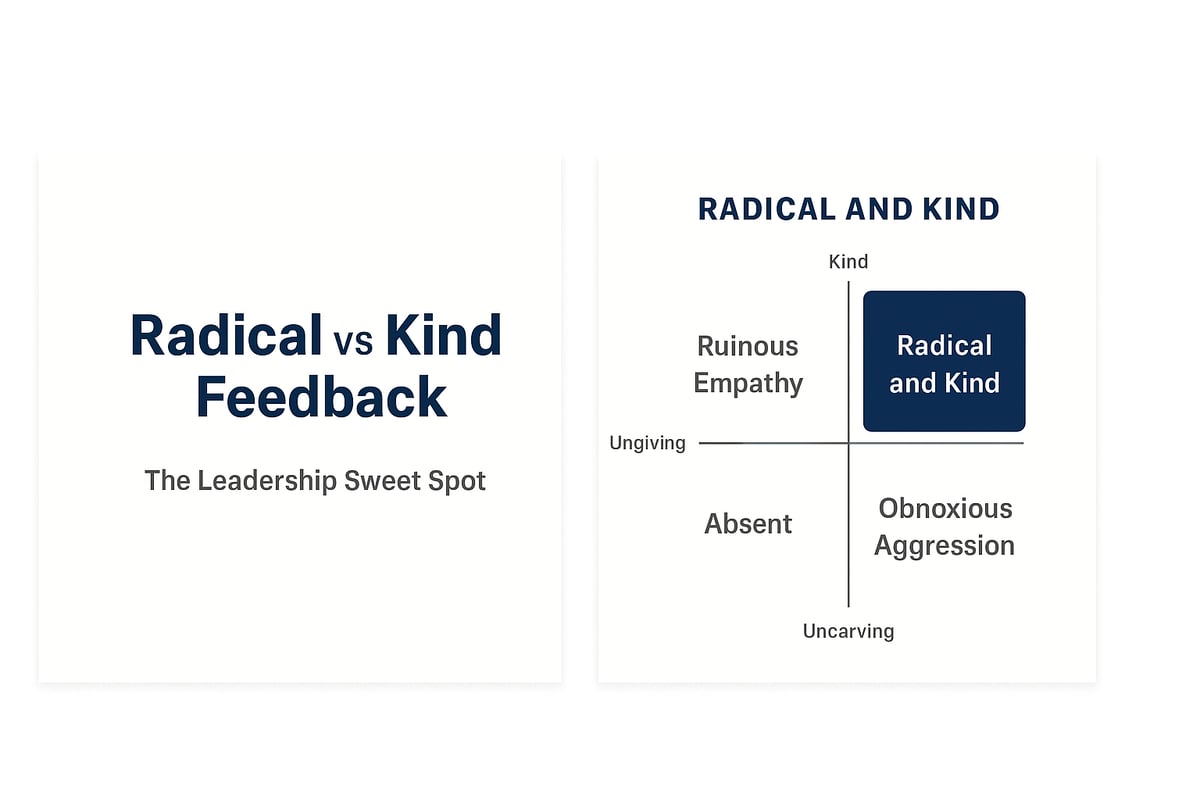Feedback isn’t just words — it’s influence in action. Whether you’re a manager, a mentor, or a colleague, the way you deliver feedback sets the tone for trust, growth, and collaboration. Poorly delivered feedback can shut down communication faster than almost anything else. But when given well, it builds bridges, inspires better performance, and demonstrates that you truly care.
That’s where the concept of “radical and kind” feedback—or “radical candor,” as popularized by Kim Scott—comes in. It’s about being both direct and empathetic, crafting feedback that hits the mark while preserving trust.

Photo by Jon Tyson on Unsplash
Let’s begin with a diagram to help us understand the subtle balance of giving feedback:

This gives us four quadrants:
Every leader should aim for the “Radical and Kind” quadrant, where truth is delivered with care—what I call the leadership sweet spot.
Radical doesn’t mean harsh. It means being clear, precise, and direct—speaking facts simply to eliminate misunderstanding. It’s not about bluntness or aggression—it’s about clarity and intention.
Kindness demonstrates intent. It shows that your goal isn’t simply to correct or criticize, but to support, guide, and enable growth. When radical clarity meets sincere care, feedback lands with impact and preserves trust.
Example:
“I’m concerned your performance over the past two months is below your potential. I know you can do better, and I want to understand what’s going on so we can find a solution together.”
This message is direct—but it’s also caring, supportive, and solution-oriented.
Unfortunately, many people perceive “radical feedback” as criticism. This reaction often stems from their vulnerability—personal stress, insecurity, or a bad day. Even the most well-intentioned feedback can be received as a personal attack.
This underscores the need for adaptation: adjusting your tone, timing, and delivery to match the person’s emotional state and context.
Effective feedback is not one-size-fits-all. It depends on:
Be observant. Silence, distractedness, or low energy may signal someone isn't ready for feedback. In these moments, consider adjusting your approach—or postponing until a better time.
Feedback isn't just about what you say—it's equally about the context. If a typically talkative colleague becomes monosyllabic, or an open person seems closed off, that’s a cue. Ignoring these signals and proceeding as planned can derail your message—and your relationship.
Attuning to context makes your feedback more compassionate, precise, and effective.
Location matters. Consider:
The right setting primes how your message is received.
You might begin determined to be radical—but if you sense defensiveness or vulnerability mid-discussion, be flexible. Pivot to a softer tone. That moment of responsiveness transforms a potentially tense conversation into a constructive, trust-building one.
Empathy is essential—but so is accountability. I like to give two chances for mistakes before I take some actions. Here’s a simple guideline:
This avoids turning support into indulgence, helping people grow responsibly.
The SBI method (Situation–Behavior–Impact) gives feedback structure and clarity:
Facts—not interpretations—make feedback actionable and respectful.
A strong feedback exchange often follows this flow:
When boundaries are crossed—such as disrespect or harassment—there’s no room for cushioning or neutral tones. You need clarity, boundary-setting, and immediacy:
“What you said just now isn’t acceptable here. It must not happen again.”
This is radical and clear, but firm—delivering a truth that’s non-negotiable.

Photo by Claudio Schwarz on Unsplash
To lead effectively, you must give feedback that’s both transparent and empathetic—the “radical and kind” approach. That means:
Ultimately, feedback isn’t about speaking—it’s about creating dialogue, driving improvement, and preserving trust. When delivered with care and candor, it becomes one of the most powerful—and human—tools a leader can use.
Find out if MentorCruise is a good fit for you – fast, free, and no pressure.
Tell us about your goals
See how mentorship compares to other options
Preview your first month
